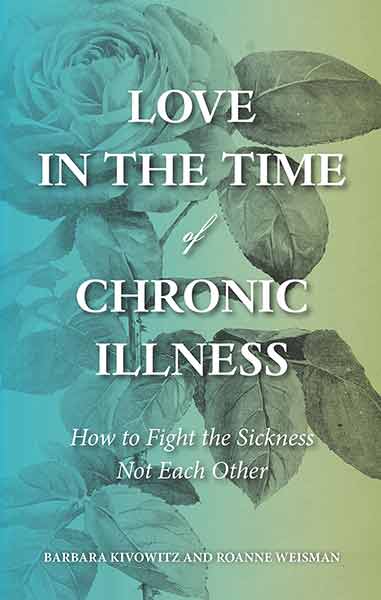Reviewed by Phillip Waite, Ph.D.

When you’re part of a couple, chronic illness may live in one person’s body, but two lives are dislocated, and two hearts and minds can be marshaled to carry the heavy load of illness. My coauthor and I wrote Love in the Time of Chronic Illness: How to Fight the Sickness, Not Each Other because we were both the ill partners in our relationships and were stunned by how deeply our conditions affected that relationship, and how important that relationship was to our recovery.
We interviewed many couples and experts and wrote the book we wished we’d had during our illness experiences andndash;a guide to help couples understand and prepare for the impact of illness on their relationship, and feel less confused and alone.
One key finding from our research is that the power and urgency of serious illness helped many couples break through the routines and irritations of everyday life and drill down to the foundation of their relationship where they found wellsprings of love and compassion. Many partners we interviewed noted that they achieved levels of connectedness and authentic communication that they believe would not have been possible had it not been for the transformative impact of illness. One expert said, “Illness can be the jolt that removes the dullness from life and unveils the potential.”
Other challenges illness introduces can be more problematic, particularly “Carrying the Load.” Serious illness can turn a partnership of equals into one of patient and caregiver. It’s not uncommon for the well partner to over-function and take on many of the daily chores, manage the bulk of the child rearing, handle finances, help the ill partner get to appointments, pick up medication, and even help the ill partner dress, bathe, eat, all while doing do a day job; and still feel that s/he is not doing enough. The ill partner can become increasingly isolated, focusing largely on the impact of the health condition. If this load imbalance is unrecognized and unaddressed, the couple can wind up sacrificing their intimacy to the demands of the illness. One way to proactively manage the load is for the couple to periodically write up a list of all tasks, sign up for tasks each partner can do, and problem solve for ways to get remaining tasks covered using extended family and community resources.
Many couples spoke of the need to counterbalance “doing” with “being.” A couple may feel so swamped by how much they have to do that they neglect to make time to just be. For the couple to replenish their reserves, they need to create space to sit together, to share their hopes and worries, to comfort each other, to enjoy what they can, to remember love. Not all couples can “be,” and remember love, of course. But many who try find that being can heighten relationship resilience, which enables them to address challenges
with their combined strength.
In the story that follows, we see how illness can magnify relationship friction and how valuable it is to use this heightened awareness to learn new approaches for addressing differences and strengthening the relationship. This is the transformative power of illness.
Clare and Bruce had left an unhappy marriage when they met and bonded quickly over their shared experiences and grievances. They dated for a year and then moved in together.
Their prevailing pattern was for Clare to make all the big decisions and for Bruce to acquiesce. This suited both their temperaments, and they sailed along smoothly, until Clare was diagnosed with uterine cancer and had major surgery.
Clare was overwhelmed by the pain of surgery and by a foreign sensation of helplessness and uncertainty and wanted attention and comfort. In the face of her diagnosis and dependency, Bruce became even more passive. Clare could no longer lead, and Bruce did not know how to take charge. Their old habits didnandrsquo;t work in the new terrain of illness.
They decided to get help from a counselor. They learned to speak their truth without blaming the other and to listen with compassion. Clare learned to accept her own needs and to tell Bruce, with kindness, when she wanted his help. Bruce learned that his avoidance was actually a passive expression of frustration and that when he stated his needs more directly, he felt more connected with himself and with Clare.
Over time Clare became more inviting, and Bruce grew more assertive. As Clare slowly recovered, they found they truly enjoyed their new ways of connecting. Illness was their jolt that gave them the opportunity to recognize stale patterns and design more meaningful connections.
With self (and partner) awareness, knowledge of how illness is affecting your relationship, deliberateness about the choices you make, and time set aside to connect, you may find you not only cope more effectively with illness, you also may grow stronger as a couple. One of our caregiver interviewees said it well: “Your life may not be
the same. But you can have a good life. Even a better life.”
Did you find this article helpful? Join us at HealingWell for support and information about your condition. Connect and share with others like you.
Barbara Kivowitz, MSW is a clinician, consultant, and author specializing in health care innovation to help organizations shift to more relationship-based models of care. She is the coauthor of Love in the Time of Chronic Illness: How to Fight the Sickness, Not Each Other – a guide for patient- caregiver partners and for the clinicians who help them. She has delivered programs based on her book at UCSF, Stanford Health, Massachusetts General Hospital, Dana Farber Cancer Center. She is a frequent speaker at conferences for patient-caregiver groups. Barbara is on the Board of Directors of San Francisco Village, on the Honorary Board of Well Spouse Organization, and on the Advisory Board of Patient and Family Centered Care Partners. She is a Patient Family Advisor at Sutter Health and Stanford Health Care.





